Multi-purpose convertiplane Ling-Temco-Vought XC-142 (USA)
After studying the experience of developing and testing convertoplanes Vertol VZ-2 and Hiller X-18, the military department decided that the tilting concept was of interest in the context of the further development of military transport aviation and could be implemented in a new project. The resulting machine could be used in the army and become a convenient means for the transfer of troops, which have no special restrictions on the parameters of landing sites. At the beginning of 1961, the military explored industry opportunities and identified their wishes. As a result, a list of requirements for a new project.
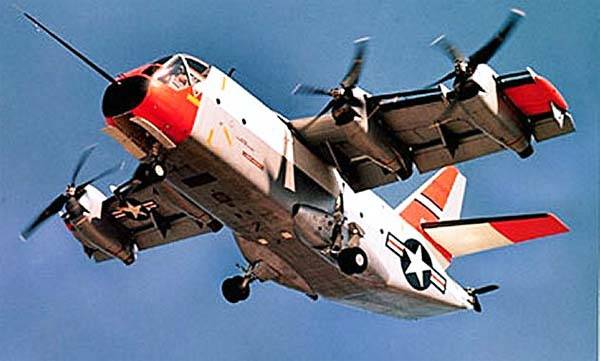
Convertible XC-142 in horizontal flight. Photo Airwar.ru
After several changes and improvements, the military department formed a final technical task. It was necessary to create an aircraft with a rotary wing, capable of taking on board up to 4,5 tons of cargo and delivering them to a distance of 400 km. The maximum horizontal flight speed was supposed to be within 560-740 km / h, cruising - from 460 to 560 km / h. In accordance with the wishes of the Marine Corps, the possibility of reducing the take-off weight to 16 t was specified, while maintaining a range of at least 190 km.
The technical task was sent to several aircraft manufacturers. Soon the Pentagon received several suggestions. After examining the documents received, the military chose the most successful project. Further work on the creation of a military transport convertoplan was to be carried out by Vought, Ryan and Hiller. The first of them had extensive experience in the creation and construction of aircraft, while the other two were recognized manufacturers of helicopter technology. It was assumed that the joint work of these organizations will allow to combine all the existing experience in a new project.
The contract for the development of a new project was signed at the beginning of 1962. In accordance with this document, in 1964, the contracting companies had to build and launch for testing the first prototype of a new technology. In the future, it was required to build four more prototypes.
A promising project received a working designation XC-142. Subsequently, after adopting the technology, such a name could lose the letter “X”, denoting the early stage of the project. Interestingly, the designation XC-142 was the last in the "old" nomenclature. Soon after, a new system of designations was introduced, implying the counting of models of equipment from one.
Initially, the full name of the project looked like Vought-Ryan-Hiller XC-142, but it was soon changed. Vought became part of the Ling-Temco-Vought conglomerate, as a result of which the convertiplane changed its name. From a certain time, it was called Ling-Temco-Vought XC-142 or abbreviated LTV XC-142. It is under this name that an interesting sample of aviation technology became widely known.
During the design, another specific change occurred. The US Navy, having seen the design characteristics of the equipment, decided to abandon further support for the project. During vertical take-off and landing, the rotors of the aircraft should have created an excessively powerful downward air flow. Navy command considered that a tiltrotor with such characteristics would pick up various debris from the ground and even knock people down. Because of this, such equipment can only be used on prepared sites, which virtually eliminated its use in real combat operations. Further development of the XC-142 project continued with the support of the Air Force and the Marine Corps.
During the development of the project, the contractors divided all major works among themselves. Most of the airframe units, control systems, cargo compartment and some other structural elements were developed by Vought engineers. Ryan was to develop the tail end of the fuselage with the tail rotor, the tail, the wing and the powerplant. The task of the company Hiller was to create the transmission and wing mechanization. This distribution of responsibilities allowed us to make the most effective use of existing experience in various fields.
In accordance with the requirements of the Pentagon, a promising convertoplane was to become a full-fledged military transport vehicle and carry various cargoes. This requirement directly affected the architecture of the machine. In general, the LTV XC-142 was supposed to be a kind of ordinary military transport aircraft. At the same time, the design provided for the characteristic features associated with the need to use the rotary wing, a special power plant, a special transmission, etc. As a result, in the configuration for horizontal flight, the convertoplane-tiltting outwardly resembled the existing machines of traditional design.
The requirement for the carriage of goods weighing up to 4,5 t led to the emergence of the corresponding form of the fuselage, which has a large cargo compartment. It was proposed to use a metal fuselage with a cross section close to rectangular. Nose compartment was given under the placement of the pilot's cabin and the necessary electronic devices. Other volumes were mainly occupied by the cabin. At the same time, volumes for placing fuel tanks were provided above the cab. The control mechanisms of the wing inclination were also placed above the cabin.
The outer contours of the fuselage were determined in accordance with the role of the machine. Thus, the tail section received an inclined bottom with a lowered loading ramp. Over this compartment was attached tail feathers of the traditional design. Directly on the fuselage there was a keel with a swept front edge, with a stabilizer on it. The plumage was equipped with the rudders of the height and direction of the traditional design.
The aircraft received a three-point chassis mounted on the fuselage. Under the cockpit and instrument compartment there was a niche for cleaning the front pillar with two small-diameter wheels. Two main racks with a pair of larger wheels on each were retracted into elliptical fairings on the sides of the fuselage.
As part of the XC-142 project, Ryan developed a new wing of the required design. An all-metal construction, made in the form of a single plane and carrying all the necessary units, was used. This wing had a cutout in the back, necessary for installation on the fuselage. In the same place there were fastenings for hinged installation. Each half wing was fitted with two engine nacelles. The entire length of the trailing edge housed the mechanization, which had in its composition flaps and ailerons. The flaps had an automatic control system, which changed its position depending on the flight mode and the angle of the wing.
The wing was movably mounted on the top of the fuselage. The tilt was controlled by a hydraulic motor connected to two screw jacks. At the command of the pilot, such drives could bring the wing with the engines to the desired position. The wing was allowed to move from a horizontal position to the angle of attack 98 °. A slight tilt of the engines back could be used in some situations.
In each of the four wing nacelles, a General Electric T64-GE-1 turboprop engine hp was placed. Each motor group had a four-bladed propeller of variable pitch by Hamilton-Standard. The screw was equipped with fiberglass blades of the 2850EF type and had a diameter of 2 m. The wing design was such that the propeller disks of the screws partially overlapped, but were in different planes: this excluded overlapping blades. During the refinement and improvement of the project, the convertoplane received propellers with blades of the 4,7FF model, but the overall architecture of the propeller groups remained the same.
Considering the problems of previous projects, Vought, Ryan and Hiller have developed a new transmission capable of eliminating some problems. Using a set of gearboxes and shafts, all four engines were connected to a common system. In addition, the torque from this system was diverted to the fuselage and fed to the longitudinal shaft. The latter reached a special support in the tail, on which a three-blade steering screw of small diameter was placed. According to the calculations, this transmission allowed vertical flight to continue even when several engines were disconnected.
The car should have been driven by a crew of three. Two pilots were placed in the bow cabin and had a good view of the front hemisphere, provided with advanced glazing. Behind the pilots was the third crew member in charge of cargo handling. Pilot cockpit controls were based on aircraft systems, and all available instruments could be used in any flight mode. The redistribution of commands to the executive mechanisms was carried out automatically and without human intervention. Control in horizontal flight should be carried out by the deviation of the rudders or ailerons. For vertical take-off or on transients, the pitch of the load-bearing and tail tail rotor was used.
The dimensions of the fuselage made it possible to get a fairly large and capacious cargo compartment. The payload could be placed in an unpressurized compartment with a length of 9,1, a width of 2,3 and a height of 2,1. The folding seats for the landing force were installed in the number of 32 units along the sides. There were several portholes in the sides. It should be noted that the initial load capacity requirements could not be met. The LTV XC-142 convertoplan could take on an 32 soldier with weapons or 3350 kg of cargo. The loading of the cabin could be carried out through two side doors, located in the front part of it, or by means of a lowered tailramp.
"Tiltving" new model had a length of 17,7 m and a wingspan of 20,6 m. The wing area - 49,67 sq.m. The height of the vehicle is 7,95 m. The mass of the empty convertiplane was 10,27 t, the maximum take-off was 20220 kg. The maximum speed reached 695 km / h, cruising - about 460 km / h. Ceiling - 7620 m. Practical radius of action does not exceed 760 km. When using our own tanks on the 370 l of fuel and two suspension tanks, the distillation range could be increased to 6100 km.
In the middle of 1964, as required by the order of the military department, the contracting companies built the first prototype of the newest military transport convertoplane. Tests started with ground checks, after which permission was received to conduct a full-fledged flight. 29 September of the same year, the first XC-142 first took to the air. The car showed itself well and confirmed the main characteristics. Moreover, very interesting opportunities were demonstrated.
The use of four turboprop engines with an 2850 horsepower. each gave the aircraft a high power supply. Takeoff and takeoff occupied the minimum possible distance, including when using not all engines. So, at maximum payload, three engines running and the XC-142 wing raised at a certain angle, having traveled a distance of length 122 m, took off and climbed to a height of 15 m. At sea level, rate of climb to 34,5 m / s was demonstrated. Even in conditions of high air temperature, this parameter could be brought to 17-18 m / s.
Exactly three months after the first flight “by plane”, an experienced tiltrotor first flew vertically. Such checks did not take much time. Already 11 January 1965, the first flight was performed with the transition between modes. Over the next few months, test pilots carried out full-scale inspections of equipment, and manufacturing companies built and handed over for testing new samples. In total, five prototypes were built in the 1964-65 years. All of them were used in tests, solving certain tasks.
From a certain time tests experienced XC-142 were carried out with the participation of representatives of the military. At this stage, the equipment not only showed its technical characteristics, but showed potential in certain situations. The military organized checks with the delivery of the landing force, the evacuation of the conditionally wounded, the discharge of people and cargo from low altitudes, etc. In general, during such tests the tiltrotor showed itself well, confirming the ability to simultaneously use the best features of airplanes and helicopters.
However, during the tests it was not without problems, since the design had certain drawbacks. A relatively complex transmission system combining four propeller groups and transmitting power to the tail rotor propeller created excessive vibrations and noise. This led to a high load on the pilots, and could also have a negative impact on the glider's resource. The swivel wing was not rigid enough, and in some situations it could bend. Applied screws Hamilton-Standard 2EF did not allow to obtain the calculated traction, which adversely affected all flight characteristics. 2FF type blades showed higher performance, but did not completely solve this problem.
The transition from vertical to horizontal flight was associated with certain problems. It turned out that when the wing is inclined from 35 ° to 80 ° relative to the horizontal, stability and controllability are impaired. At low altitudes, characteristic of the transition from one regime to another, such features of the behavior of the machine could be associated with risks.
The presence of a number of serious problems could not lead to various accidents. Various minor breakdowns occurred regularly, but several times certain factors led to serious accidents. October 19 1965 of the prototype №2 during the flight caught fire one of the engines. The flames significantly damaged the propeller and wing structure. It required serious repairs. 4 January 1966-th prototype number 3 during the flight "helicopter" made a hard landing with damage to the fuselage. These two cars have decided not to restore the original form. On the contrary, they collected one flight copy. On the whole fuselage of the second prototype put the whole wing from the third. In this form, the machine number XXUMX continued testing.
27 January 1966 of the year on the fourth experienced LTV XC-142 during the flight the gearbox collapsed. The debris with high speed scattered in different directions, damaging the gondola, wing, fuselage and some other units. Subsequently, the car was restored and re-attracted to the tests. In December of the same year there was a small accident with the fifth prototype. Due to pilot error, the nose wheel hydraulic actuators were not included. Not being able to turn, the plane collided with a ground structure. Damage received fuselage, wing and propeller groups.
In 1966, the armed forces conducted operational tests, the results of which could lead to a decision on the mass production of new equipment. Prototype №5 under the control of pilots of the air and naval forces carried out takeoffs and landings on both land aerodromes and aircraft carriers. In a few days, 44 shortened takeoff and landing on the deck of the aircraft carrier USS Bennington (CV-20) and other ships with a flight deck. In addition, the unit took off six times and sat vertically on the deck. During such tests, the wing and its mechanization were installed at various angles. The wind speed and direction, as well as other conditions, were repeatedly changed, but all the tests were completed successfully. We checked the capabilities of vehicles in rescue operations. Being at a height of no more than 40 m, the tiltrotor successfully managed to climb aboard the conditional drowning man.
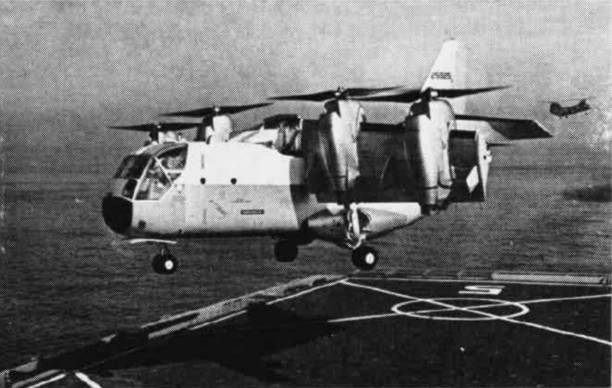
Take off from the deck, November 28 1966 g. Photo by US Navy
In May 1967, the first prototype of the convertoplan carried out its 148 test flight. The task implied an ascent to the height of 2440 m followed by a descent to 915 m. In the course of these tests, the use of an aircraft in a search and rescue operation was tested. Being at a lower altitude, the experienced XC-142 suddenly rolled over his nose. The crew could not do anything, because of what the car fell into the woods. The broken prototype was destroyed by fire.
By the middle of 1967, five prototypes running 39 pilots managed to fly a total of 420 hours. "Tiltving" LTV XC-142 showed quite high performance, and also confirmed the possibility of solving various problems. Now the last word remained for the customer, who could adopt the machine and order mass production.
However, this did not happen. After examining the results of all the tests carried out, Pentagon experts concluded that there was no need to adopt such equipment for service. In its current form, the XC-142 was not devoid of technical or other shortcomings, but at the same time it was notable for its complexity and high cost. In addition, he could hardly find a place in the structure of military transport aviation, already rebuilt for use of airplanes and helicopters. The machine, having the qualities of both classes of technology, hardly fit into the existing system.
Following a study of the original technology, it was decided to further develop military transport aviation. The tasks associated with the need to take off or land at small sites were proposed to be solved exclusively with the help of helicopters: all the more, by this time machines had appeared that could be compared in terms of carrying capacity with the convertiplane XC-142. The relatively low flight speed characteristic of helicopters was not considered a serious shortcoming. Such approaches to the formation of the fleet of aircraft allowed to transport people and goods, but they were not associated with excessive costs.
By the time the decision was made to abandon the further development of the project, four prototypes of XC-142 remained available. Soon, this technique was transferred to NASA to conduct new research. A variety of tests and checks were carried out at Langley airbase until the early seventies. Completion of tests and development of the resource determined the further fate of the equipment. Three converters were sent for disassembly. Only prototype model number XXUMX escaped this fate and was transferred to the Wright-Patterson air base museum, where it is still kept.
The Vought-Ryan-Hiller / Ling-Temco-Vought XC-142 project was the first and last attempt by the US aviation industry to bring the tiltwing-type aircraft to practical operation. Using the already well-known ideas and some new solutions, the three companies were able to work together to create a very interesting model capable of solving various transport and other tasks. However, in parallel with the work on the project XC-142 was the development of helicopters. Much more significant progress was made in this area, because of which the customer eventually abandoned the unusual aircraft. No new attempts were made to bring the tiltrotor-tiltving of military transport to practical use.
On the materials of the sites:
http://aviastar.org/
http://airwar.ru/
http://aviadejavu.ru/
http://globalsecurity.org/
http://nationalmuseum.af.mil/
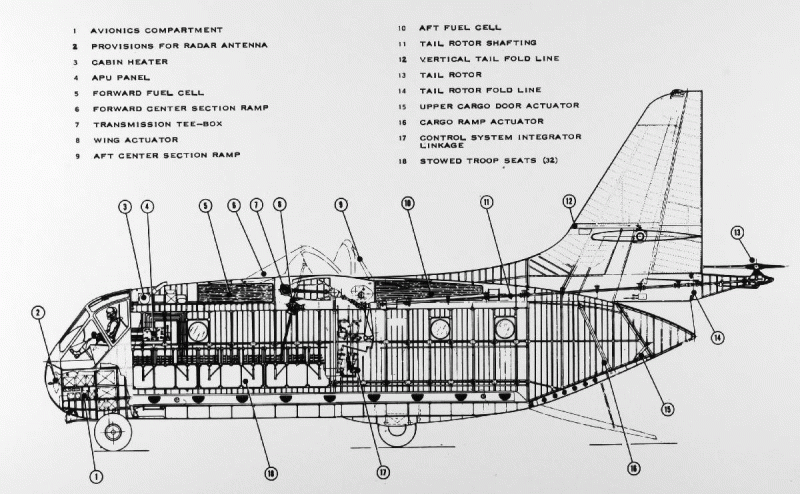
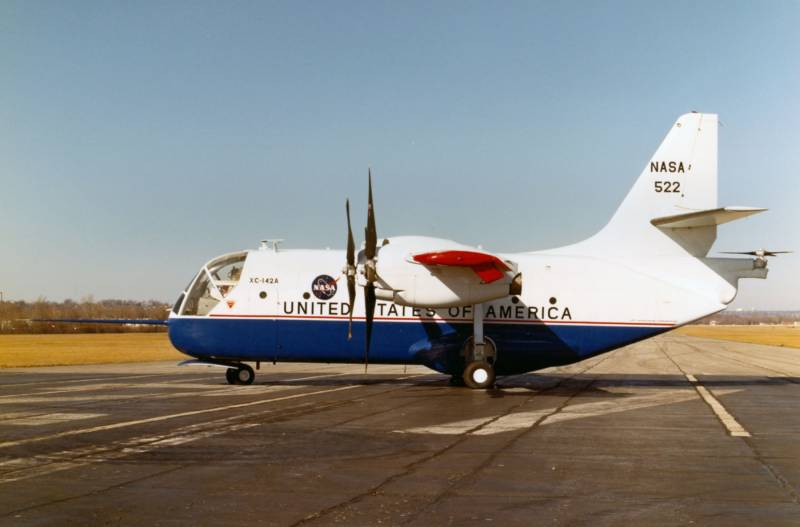
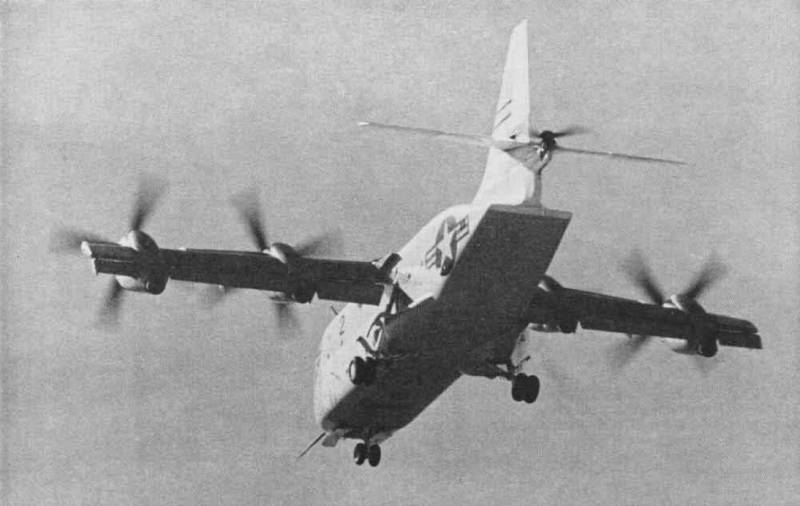
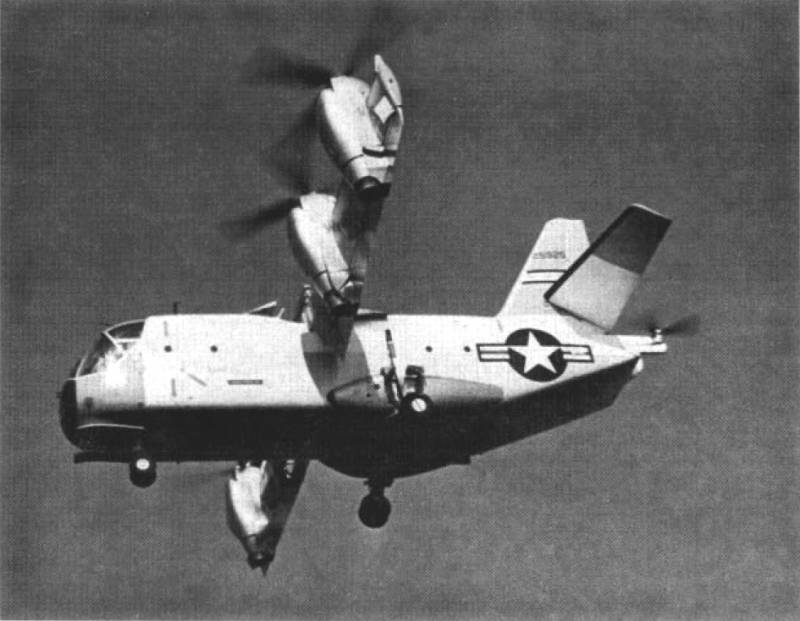
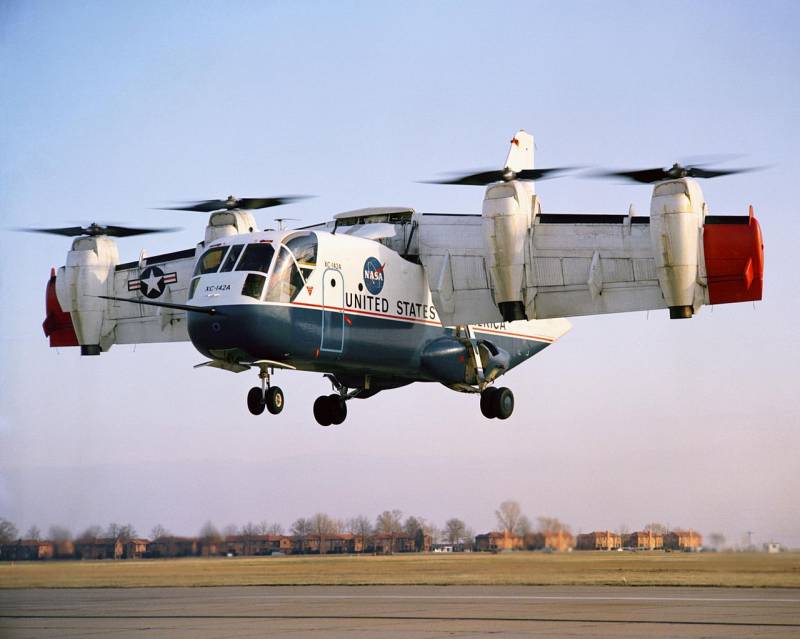
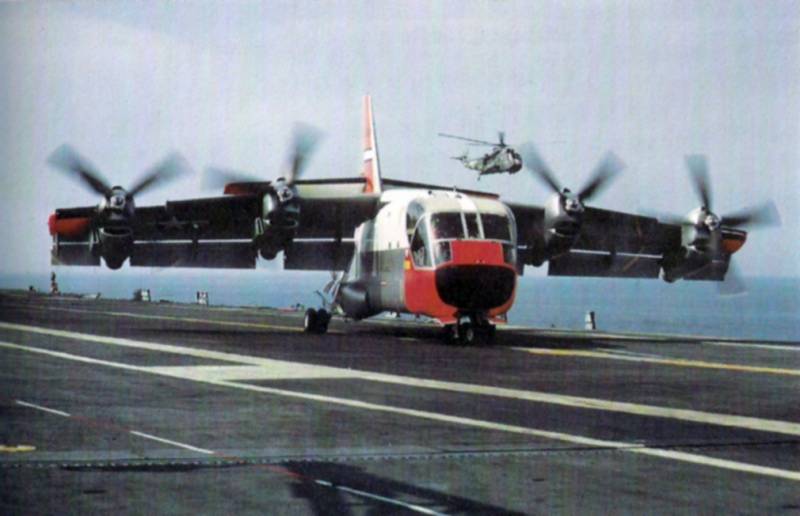
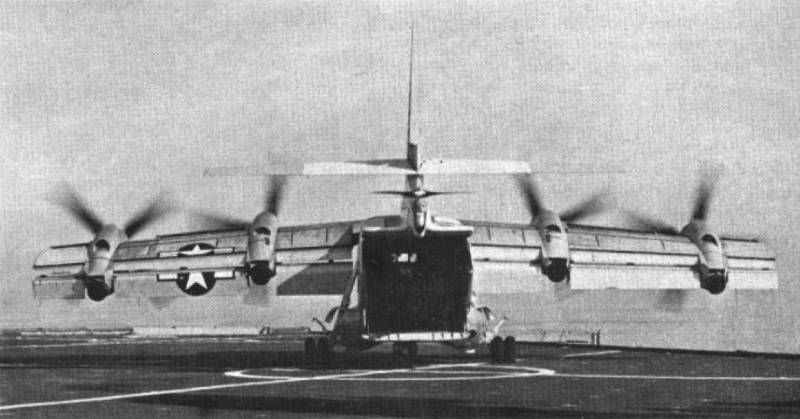
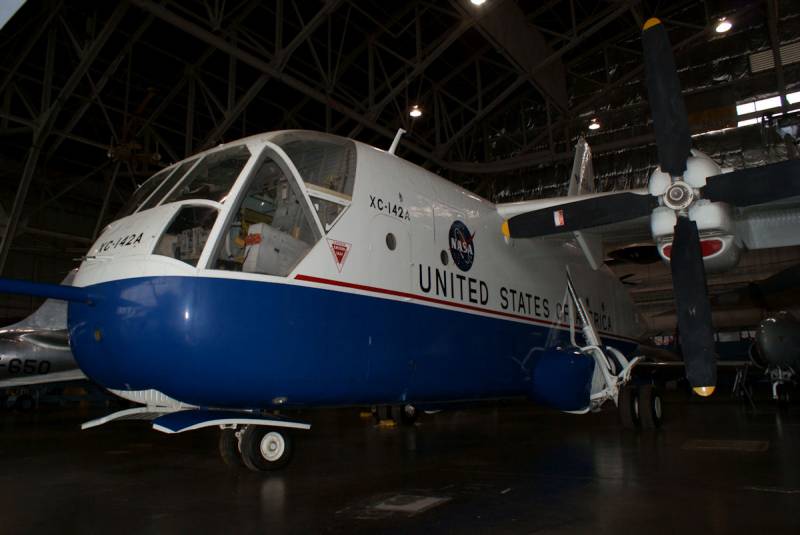
Information